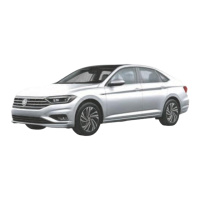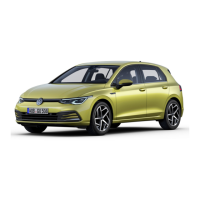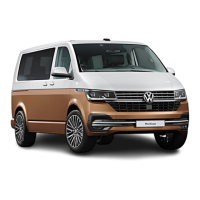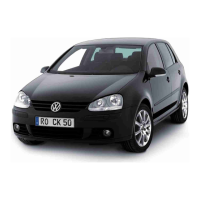Fitting and using a
child
seat
—
Weight group 0/0+: From birth to approx. 18
months of age, it is best to use the baby seat
facing in the opposite direction to the direction
of travel → fig. 42 of group 0/0+ or 0/1.
—
Weight group 1: Once the weight limit of the
previous weight group has been reached, it is
best to use child seats in weight group 1 (up to
approx. 4 years) and weight group 1/2 (up to
approx. 7 years) with an integrated harness
system ( ).
—
Weight groups 2/3: Child seats with backrests
and backless booster cushions belong to groups
2 and 3. Child seats with backrests offer more
protection than backless booster cushions due
to their high backrest.
The seatbelt guide and side impact protectors
are integrated into the seatbelt belt guide.
Volkswagen therefore recommends the use of
child seats with backrests. Group 2 child seats
are suitable for children up to approx. 7 years of
age, and Group 3 child seats are suitable for
children from approx. 7 years of age upwards.
Not all children fit in the seat of the weight group to
which they belong and not all child seats are suitable
for all vehicles. Therefore, always check whether the
child will fit properly in the child seat and whether
the child seat can be securely fastened in the
vehicle.
Child seats by approval category
Child seats may have a "universal", "semi-
universal", "vehicle specific" (all according to ECE-
R 44) or "i-Size" (according to ECE-R 44) type-
approval category.
R 129).
—
Universal: Child seats with the "universal"
designation can be fitted in all vehicles. It is not
necessary to consult a model list. In the case of
uni- versal approval for ISOFIX, the child seat
must additionally be fitted with a top tether belt
(Top Tether).
—
Semi-universal: In addition to the standard
requirements of the universal approval, the
"semi-universal" approval requires additional
safety devices for securing the child seat which
are subject to additional tests. Child seats with
"semi-universal" approval include a list of vehicle
models in which they can be fitted.
—
Vehicle specific
:
Vehicle specific
approval
requires a dynamic test of the child seat for
each vehicle model separately. Child seats with
vehicle-specific type-approval include a vehicle-
specific child seat.
They also list the vehicle models on which they
can be fitted.
—
i-Size: Child seats with "i-Size" approval must
comply with the installation and safety
requirements of ECE-R 129. Child seat
manufacturers can tell you which seats have i-
Size approval for this vehicle.
Please note and at the beginning of this
chapter on page 52.
Fig. 43 Schematic representation: airbag sticker on the
sun visor.
Fig. 44 Schematic representation: airbag sticker on the
B-pillar.
Country-specific provisions
The rules and regulations on the use of child seats
and their attachment options vary from country to
country. It is not permitted in all countries to carry
children in the front passenger seat. The legal
provisions and regulations always take precedence
over the descriptions in these operating
instructions.

